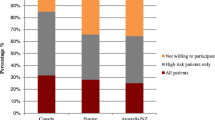Abstract
Although the past five decades have witnessed dramatic transformations in dialysis technologies and health-care infrastructure, the fundamental dependence of each patient undergoing maintenance hemodialysis on long-term reliable vascular access has remained unchanged. The past decade in the United States has witnessed the development and implementation of a number of vascular access initiatives led by a variety of different stakeholders focused on increasing the prevalence of arteriovenous fistulas and limiting the use of central venous catheters in hemodialysis patients. These have included the Fistula First Initiative most prominently and also include the Centers for Medicare and Medicaid Services End-Stage Renal Disease Quality Incentive Program, the Healthy People 2020 campaign, and the Renal Physicians Association Vascular Access Initiative. Coinciding with implementation of these initiatives has been an acceleration of a marked transition from the dominant use of arteriovenous grafts to that of arteriovenous fistulas among individuals in the United States undergoing maintenance hemodialysis. In contrast to the distribution of vascular access types used by prevalent patients, the distribution of access use by patients starting maintenance hemodialysis has shown remarkably little change over the past decade. Over the past 3–4 years, recognition of the plateauing proportion of prevalent hemodialysis patients using fistulas as well as the persistently and unacceptably high proportion of patients starting dialysis with catheters has led to calls to reorient the Fistula First Initiative to include a renewed emphasis on primarily discouraging the long-term use of central venous catheters.
Access this chapter
Tax calculation will be finalised at checkout
Purchases are for personal use only
Similar content being viewed by others
Bibliography
Al-Jaishi AA, Oliver MJ, Thomas SM, et al. Patency rates of the arteriovenous fistula for hemodialysis: a systematic review and meta-analysis. Am J Kidney Dis. 2014;63:464–78.
Astor BC, Eustace JA, Powe NR, et al. Type of vascular access and survival among incident hemodialysis patients: the Choices for Healthy Outcomes in Caring for ESRD (CHOICE) study. J Am Soc Nephrol. 2005;16:1449–55.
Baker LD, Johnson JM, Goldfarb D. Expanded polytetrafluoroethylene (PTFE) subcutaneous arteriovenous conduit: an improved vascular access for chronic hemodialysis. Trans Am Soc Artif Intern Organs. 1976;22:382–7.
Bradbury BD, Chen F, Furniss A, et al. Conversion of vascular access type among incident hemodialysis patients: description and association with mortality. Am J Kidney Dis. 2009;53:804–14.
Brescia MJ, Cimino JE, Appel K, Hurwich BJ. Chronic hemodialysis using venipuncture and a surgically created arteriovenous fistula. N Engl J Med. 1966;275:1089–92.
Combe C, Bérard X. Dialysis: “Catheter Last” not “Fistula First” in elderly patients. Nat Rev Nephrol. 2013;9:632–4.
Dember LM, Imrey PB, Beck GJ, et al. Objectives and design of the hemodialysis Fistula maturation study. Am J Kidney Dis. 2014;63:104–12.
DeSilva RN, Patibandla BK, Vin Y, et al. Fistula first is not always the best strategy for the elderly. J Am Soc Nephrol. 2013;24:1297–304.
ESRD National Coordinating Center. Fistula First Catheter Last Initiative. 2015. www.esrdncc.org/ffcl/. Accessed 22 June 2015.
Feldman HI, Held PJ, Hutchinson JT, et al. Hemodialysis vascular access morbidity in the United States. Kidney Int. 1993;43:1091–6.
Finelli L, Miller JT, Tokars JI, et al. Special article: national surveillance of dialysis-associated diseases in the United States, 2002. Semin Dial. 2005;18:52–61.
Hicks CW, Canner JK, Arhuidese I, et al. Mortality benefits of different hemodialysis access types are age dependent. J Vasc Surg. 2015;61:449–56.
Lacson E, Wang W, Lazarus JM, Hakim RM. Change in vascular access and hospitalization risk in long-term hemodialysis patients. Clin J Am Soc Nephrol. 2010;5:1996–2003.
Lee T, Thamer M, Zhang Y, et al. Outcomes of elderly patients after Predialysis vascular access creation. J Am Soc Nephrol. 2015;26(12):3133–40. ASN.2014090938.
Lok CE. Fistula First Initiative: advantages and pitfalls. Clin J Am Soc Nephrol. 2007;2:1043–53.
Lok CE, Foley R. Vascular access morbidity and mortality: trends of the last decade. Clin J Am Soc Nephrol. 2013;8:1213–9.
NKF KDQOI Vascular Access Work Group. Clinical practice guidelines for vascular access. Am J Kidney Dis. 2006;48 Suppl 1:S176–247.
O’Hare AM, Bertenthal D, Walter LC, et al. When to refer patients with chronic kidney disease for vascular access surgery: should age be a consideration? Kidney Int. 2007;71:555–61.
Polkinghorne KR, McDonald SP, Atkins RC, Kerr PG. Vascular access and All-cause mortality: a propensity score analysis. J Am Soc Nephrol. 2004;15:477–86.
Ravani P, Palmer SC, Oliver MJ, et al. Associations between hemodialysis access type and clinical outcomes: a systematic review. J Am Soc Nephrol. 2013;24:465–73.
Renal Physicians Association. Vascular access initiative. 2011. http://www.renalmd.org/page.aspx?id=2544. Accessed 24 June 2015.
Rivara MB, Mehrotra R. Is early initiation of dialysis harmful? Semin Dial. 2014;27:250–2.
Schwab SJ, Buller GL, McCann RL, et al. Prospective evaluation of a Dacron cuffed hemodialysis catheter for prolonged use. Am J Kidney Dis. 1988;11:166–9.
United States Renal Data System. 2014 USRDS annual data report. An overview of the epidemiology of kidney disease in the United States. Bethesda: National Institutes of Health, National Institute of Diabetes and Digestive and Kidney Diseases; 2014.
Vassalotti JA, Jennings WC, Beathard GA, et al. Fistula first breakthrough initiative: targeting catheter last in fistula first. Semin Dial. 2012;25:303–10.
Wish JB. Vascular access for dialysis in the United States: progress, hurdles, controversies, and the future. Semin Dial. 2010;23:614–8.
Acknowledgments
Some data reported in this chapter have been supplied by the US Renal Data System (USRDS) and the Fistula First Catheter Last (FFCL) Coalition. The interpretation and reporting of these data are the responsibility of the authors and in no way should be seen as an official policy or interpretation of the US government.
Author information
Authors and Affiliations
Corresponding author
Editor information
Editors and Affiliations
Rights and permissions
Copyright information
© 2017 Springer International Publishing Switzerland
About this chapter
Cite this chapter
Rivara, M.B., Mehrotra, R. (2017). The Current State of Hemodialysis Access and Dialysis Access Initiatives in the United States. In: Shalhub, S., Dua, A., Shin, S. (eds) Hemodialysis Access. Springer, Cham. https://doi.org/10.1007/978-3-319-40061-7_3
Download citation
DOI: https://doi.org/10.1007/978-3-319-40061-7_3
Published:
Publisher Name: Springer, Cham
Print ISBN: 978-3-319-40059-4
Online ISBN: 978-3-319-40061-7
eBook Packages: MedicineMedicine (R0)




